dieciseite dia (el domingo, el doce de febrero)
It’s the last morning in Antigua and I am awakened by vendors yelling at 5 am. I puzzle what they might be selling so early and remember our hotel is a block away from the big market. At 5:30 am, I also became a little nostalgic when I heard distant gallo (roosters). Our driver Mario later tells me that it is bus conductors calling out destinations. He also adds that some are newspaper boys doing the Spanish version of, ‘Extra, Extra; Read all about it.’
We’re enroute to Quetzaltenango (also known as Xela and pronounced Che-la) for the next five days and making a stop at Chichicastenango because of its famous Sunday Market. We arrive at our mid-day stop after three hours through steep, sometimes narrow and often winding roads.
Patricia, our tour leader, right away gives us timings and destinations to meet up at 1 pm and then 3 pm Looking at the busy, crowded market, it makes sense. I felt we needed leashes or some kind of cord to keep track of each other as we moved through the market. Our group of 11 is not going to be able to stay together.
We stopped at the Catholic Church since it was a Sunday. The experience took me back to India where the poor are often begging outside temples and looking for generosity from worshipers. Older women and young girls, with babies straddled on their back, followed us into the Church. Many were petite and some were barely taller than my waist. Guatemala has the shortest women in the world, averaging 4’9.” Growing up in India, I felt out of place at 5’8” since the average woman was 5’2” and male was 5’7.” I was reminded of the times when I would slouch while travelling in public transport because I didn’t want to feel out of place. Thankfully, I have developed a better sense of self since and don’t always feel uncomfortable or have the need to fit in.
Neil, Marilyn, Laurel and I navigate the market together and run into young Jeremiah who was selling hand-made flutes to fund his education. He was proficient in Maya K’iche,’ Spanish, English, French and Italian and said he had picked the last three languages at the market. He was a charming boy and Marilyn was soon being convinced to buy a flute. She ends up with two!
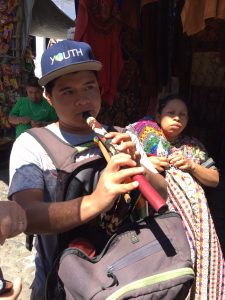
The enterprising Jeremiah
We came across Maria Hasina, another articulate young Mayan woman, who could answer our questions in English. Since she was only selling embroidery threads, there was no pressure for us to buy! She told us that her cotton and silk threads came from India, China and Columbia. The silk from China were of a higher quality and determined by the quality of water that the silkworms consumed. Maria had studied English in the U.S.A. for three months and then History of Science in Brazil.
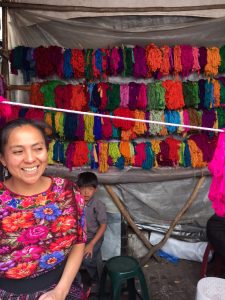
She was showing us patterns on her mother-in-law’s blouse explaining that the ancient geometric Mayan patterns appear in many cultures and closely related to astronomy. She showed us the pattern of the sun around the neckline and four moons in different positions on the vest.
We have lunch in a lovely restaurant and need to pass another another hour before we get on our shuttle. Laurel takes off to do more window (actually open air) shopping while Neil, Marilyn and I hold back – mainly because we don’t need to shop. Then after half an hour decide to make our way back. We spot a crowd and instantly know what that is about!
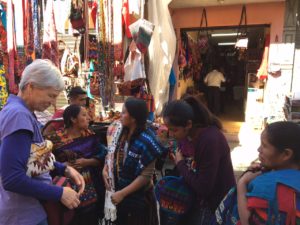
Like bees to honey is how street vendors are to Laurel. It could very well be the other way around as Laurel can’t stop admiring the clothing or resist the temptation to buy.
My minimalist self is behaving herself and I am grateful to have no temptation.
And my suitcase is still weighing heavy on my conscience!


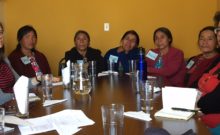

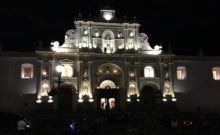
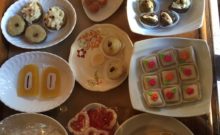

Leave a Comment